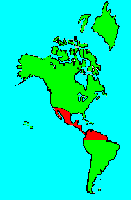SPECIES INFO
Tropical Rattlesnake (Crotalus durissus) is widely found from Mexico through Central America through Brazil. This species prefers the arid areas, and is not found in the rain forests, the Andes, or the arid area west of the Andes mountains. This is a very variable species. Large examples can be up to five feet long, but most examples are less than four feet in length or slightly less. About 15 different subspecies that are recognized,
This large rattlesnake has a very mean temperament and its venom is especially potent. The venom frequently attacks the neck muscles in man and the victim cannot hold his head up giving rise to the legend that this species breaks the necks of its victims.Rattlesnake genus (Crotalus) contains species that are typically larger than the pygmy rattlesnake genus (Sistrurus). Technically the scales on the dorsal side between the eyes can help separate the two genera. The Sistrurus genus has a few large scales (nine) between the eyes while the Crotalus genus has numerous smaller scales between the eyes.
Rattlesnakes (Genus Crotalus & genus Sistrurus) are a group of snakes found primarily in the southern United States and in Mexico. Most of the species are found in the southwestern United States of Arizona, New Mexico, and adjacent areas. However, one species, the Neotropical Rattlesnake (Crotalus durissus), is found from Mexico to Argentina. These snakes are characterized by having a unique rattle at the end of their tail that is shaken when these animals are aroused. Rattlesnakes are known for the speed of their strike and their very long fangs which are folded back into the mouth when not in use. Their venom can be deadly. Following is a partial species list (key: * = pictured):
Thirty species in the family are listed here. Eighteen of the more common and more widespread species are pictured and discussed. (C. aquilus is subspecies of C. triseriatus.)
SCIENTIFIC NAME - - COMMON NAME - - DISTRIBUTION
C. adamanteus* - E. Diamondback - SE USA
C. atrox - W. Diamondback - SW USA & nearby Mex.
C. basiliscus - Mex. West Coast - W. Coastal Mexico
C. catalinensis - Catalina Rattleless - St. Catalina (Gulf)
C. cerastes* - Sidewinder - SW USA & nearby Mex
.
C. durissus* - Neotropical - Neotropics
C. enyo* - Baja - Baja California
C. exsul - Cedros Island - Cedros Island
C. horridus* - Timber - East USA
C. intermedius - Small Headed - Local S. Mexico
C. lannomi - Autlan (one known) - Jalisco, W. Mexico
C. lepidus* - Rock - SW USA and adj Mex.
C. mitchellii* - Speckled - SW USA and Baja
C. molossus* - Black Tail - SW USA and Mexico
C. polystictus - Lance Headed - SC Mexico
C. pricei* - Twin Spot - Mexico Highlands
C. pusillus - Tancitaran Dusky - Local SW Baja
C. ruber* - Red Diamond - S. California & Baja
C. scutelatus* - Mojave - SW USA & Mexico
C. stejnegeri - Long Tail - Local WC Mexico
C. tigris* - Tiger - Sonora and adj USA
C. tortugensis - Tortuga Island - Tortuga in Gulf
C. transversus - Cross Banded - Local S. Mexico
C. triseriatus - Mexican Dusky - S. Mexico
C. tris. Aquilius - Queretaran Dusky - SC Mexico
C. viridis* - Western - West US
C. willardii* - Ridge Nosed - N.Mex Highlands,etc.
S. catenatus* - Massassauga - C. USA
S. miliarius* - Pygmy - SE USA
S. ravus* - Mexican Pygmy - SC Mexico - Local
Vipers (Family Viperidae) are an almost worldwide group of poisonous snakes with excellent striking ability. They open their mouths very wide when striking and their hollow fangs can penetrate deeply to permit large amounts of venom to be deposited. Any bite should be considered very serious and should get immediate medical attention. Many of the species have very deadly venom.
Included in this group are the rattlesnakes, copperhead, and water moccasins of the New World. Also included in this family are the Old World adders and vipers. There are about 230 species in the Viperidae family. This family can be further divided into subfamilies. The two best known sub-families are the Old World Vipers (wo pits) (Viperinae) and the Pit vipers (Crotalinae).
Lizards and Snakes (Squamata Order) share many common characteristics and consequently they are grouped in a single order. There are greater differences between some groups of lizards than there are between other groups of lizards and snakes. The same is true of snakes. Lizards and snakes share a common skull shape.
There are perhaps 4,000 species of lizards and perhaps 2,700 species of snakes alive today. In the Great Big Book of Snakes and Reptiles published in 2014, they noted the above estimates.
Reptiles (Class Reptilia) are an ancient group of scaled chordates. These scales may be permanently joined, as in the turtles, or flexible, as in the snakes. Reptiles are land-based. Their eggs are laid on land and the young are air breathing.
In the Great Big Book of Snakes and Reptiles published in 2014, they noted that there are more than 7,000 species of reptiles alive today.
Backboned Animals (Phylum Chordata) are the most advanced group of animals on earth. These animals are characterized by having a spinal cord or backbone. Most members have a clearly defined brain that controls the organism through a spinal cord. Fish, amphibians, reptiles, birds, and mammals are in this phylum.
Currently, some taxonomists believe that the fish should be divided into two groups (sharks and regular fishes) and that there are some other primitive groups in the phylum such as hagfish or lampreys.
Animal Kingdom contains numerous organisms that feed on other animals or plants. Included in the animal kingdom are the lower marine invertebrates such as sponges and corals, the jointed legged animals such as insects and spiders, and the backboned animals such as fish, amphibians, reptiles, birds, and mammals.


